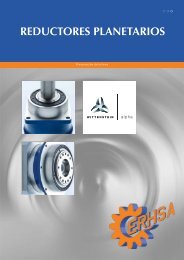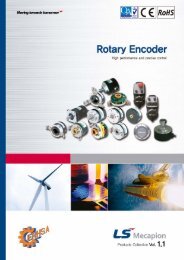Download PDF
Download PDF
Download PDF
- No tags were found...
You also want an ePaper? Increase the reach of your titles
YUMPU automatically turns print PDFs into web optimized ePapers that Google loves.
INTORQ I Clutch-brake combinations I en 5/2007Clutch-brake combinationsDimensioningSafety factorIn order to achieve the required transmission security evenin extreme operating conditions, the calculated torque ismultiplied by safety factor K. The value of K is determined bythe operating conditions. K 2Load typesIn practice, the following load types mainly occur:| Purely dynamic loadA purely dynamic load is present when flywheels, rolls orsimilar are to be accelerated or decelerated andthe static load torque is negligible.M req = M a · K M KM a =J load · ∆n 09.55 · $t 3 - t 122 %M req =J load · ∆n 09.55 · $t 3 - t 122 %· K| Dynamic and static loadThe majority of applications belong to this mixed category,as a dynamic load is present in addition to a static loadtorque in most cases.M req = (M a M load ) · K M KThe required size is usually calculated using the clutch oracceleration process.M reqT=IJ load · ∆n 0 Mload · K9.55 · $t 3 - t 122 %+M load = to engage clutch and accelerate load–M load = to engage brake and decelerate loadEstimated required torque or sizeIf only the drive power to be transmitted is known, therequired torque or braking torque can be determined asfollows:Acceleration and delay timeIf the rated torque is specified and the moment of inertiaand load torque are both known, the acceleration or delaytime can be determined as follows:M req = 9550 P · K MK nt 3 =Jload · ∆n 0 t 129.55 · (M K M load ) 2–M load = to engage clutch and accelerate load+M load = to engage brake and decelerate load13






